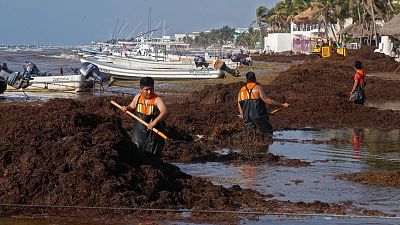Pristine beaches in Mexico and Belize are covered in foul-smelling seaweed

Millions of tons of brown seaweed is washing up along Mexico’s beaches and it’s putting the country’s post-COVID travel boom at risk.
Sargassum seaweed has been washing up on the Caribbean coast in record amounts. It gives a brown tint to crystal clear waters and emits a sewage-like stench when it washes ashore, according to the University of South Florida.
There were 24.2 million tons recorded in the last month in the Caribbean region, up from 18.8 million tons in May.
The boom in sargassum poses a “significant threat” to the country’s post-pandemic tourism recovery, analysts from bank BBVA warn. Particularly in Quintana Roo state, home to destinations like Cancun, Tulum and Playa del Carmen.
Mexico’s Navy and local workers have been drafted in to remove it from the water and sand.
“The sargassum is not a problem that can be solved, but must constantly be addressed, mainly in the summer months,” BBVA said on Monday.
Mexico’s GDP from tourism took a 25 per cent hit in real terms in 2020 due to the pandemic, even though the country never closed its borders. In 2021, however, the sector rebounded to near pre-pandemic levels – but the upward trajectory is in danger unless the seaweed is controlled.
Researchers blame multiple factors, including climate change, human sewage, agricultural runoff (water leaking out from fields) and dust blowing west from Africa’s Sahara Desert.
Is seaweed a problem anywhere else?
Since 2011, seaweed in Mexico and across the Caribbean has exploded for reasons scientists do not yet fully understand.
Belize has recently seen an uptick in sargassum seaweed polluting its beaches too. The locations where high concentrations are particularly bad are Hopkins and Placencia in the south of the country.
We spoke to Laura McMullen, a sustainability consultant in the UK, who was on holiday in Caye Caulker in Belize in May 2022.
“There was this strange seaweed washing up all over the Mesoamerican reef,” she tells Euronews Green.
“There was some of it last year but [locals have] never seen it this bad. It’s washing up on all the islands. It then decomposes and it has a really bad smell. They’re trying to get rid of it but it’s growing so much more because of climate change – the temperatures are much higher and the seas are much warmer.
“It’s impacting scuba diving, tourism, everything,” says Laura.
How are local businesses tackling the seaweed problem?
Hotel chains and restaurants along the beaches in Mexico and Belize have created taskforces of dozens of island workers to try and deal with it.
They try to keep their areas clean for customers, but public beaches are overwhelmed by the expansive seaweed carpets.
Belize’s San Pedro Town Council announced in March that it would spend around $20,000 (€19,454) every year to rid the beaches of seaweed.
